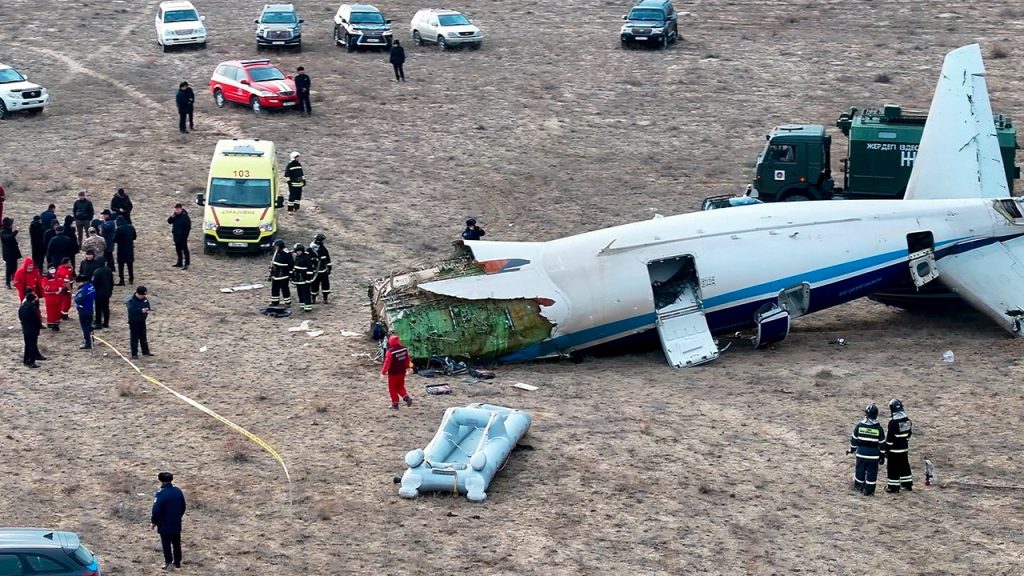The Caspian Sea Tragedy: A Flight’s Fatal Deviation
On a fateful Wednesday, the tranquil waters of the Caspian Sea became the scene of a devastating aviation disaster. An Embraer 190 passenger jet, operated by Azerbaijan Airlines, plunged into the sea near the city of Aktau, Kazakhstan, claiming the lives of dozens of passengers and crew. Flight J2-8243, en route from Azerbaijan to Russia, veered drastically off its planned trajectory, crashing hundreds of miles from its intended destination on the opposite shore of the Caspian Sea. The aircraft carried a total of 67 individuals – 62 passengers and 5 crew members. Kazakh authorities swiftly initiated rescue operations, managing to pull 32 survivors from the wreckage. However, the fate of many remained uncertain amidst the chaotic aftermath.
The tragic incident unfolded amidst heightened geopolitical tensions, with reports of drone strikes in southern Russia emerging shortly before the crash. Although no immediate link was established, the proximity of the events raised concerns about potential connections. Drone activity has previously disrupted air travel in the region, prompting airport closures. Significantly, the nearest Russian airport along the plane’s flight path was closed on the morning of the crash. While the reasons behind the plane’s dramatic deviation remained unclear, Russian aviation authorities tentatively attributed the emergency to a possible bird strike. However, the full circumstances leading to the disaster required a thorough investigation.
The passenger manifest revealed a diverse group on board the ill-fated flight, comprising 42 Azerbaijani citizens, 16 Russians, 6 Kazakhs, and 3 Kyrgyzstani nationals. Early assessments by emergency responders at the crash site, as reported by Russian news agency Interfax, indicated the loss of both pilots. As rescue efforts continued, the grim task of recovering bodies began, with four retrieved initially, a number expected to tragically rise. Twenty-nine survivors, including two children, received urgent medical attention at nearby hospitals, while the search for the remaining passengers continued relentlessly.
Disturbing footage of the crash captured the plane’s rapid descent, culminating in a fiery impact with the seashore. The ensuing inferno sent plumes of thick black smoke billowing into the sky. Amidst the wreckage, survivors, bloodied and bruised, were seen struggling to extricate themselves from a section of the fuselage that had miraculously remained intact. The harrowing scenes underscored the magnitude of the tragedy and the desperate struggle for survival.
News of the crash sent shockwaves through Azerbaijan, prompting President Ilham Aliyev to cut short his trip to Russia and return home immediately. The president had been en route to St. Petersburg for an informal summit of the Commonwealth of Independent States, a coalition of former Soviet nations. Deeply affected by the tragedy, President Aliyev expressed his heartfelt condolences to the bereaved families and wished for the swift recovery of the injured. He further declared December 26th a national day of mourning in Azerbaijan, a solemn tribute to the lives lost.
Azerbaijan Airlines, grappling with the immense loss, pledged to keep the public informed as the investigation unfolded. The airline’s social media platforms reflected the somber mood, with banners replaced by solid black. In a poignant statement on X (formerly Twitter), the airline expressed its profound grief, stating, "We ask God for mercy on the passengers and crew members who lost their lives. Their pain is our pain. We wish a speedy recovery to those injured." The tragedy served as a stark reminder of the inherent risks of air travel and the profound impact such disasters have on individuals, families, and nations. The investigation into the crash is ongoing, seeking to unravel the chain of events that led to this devastating loss of life.

